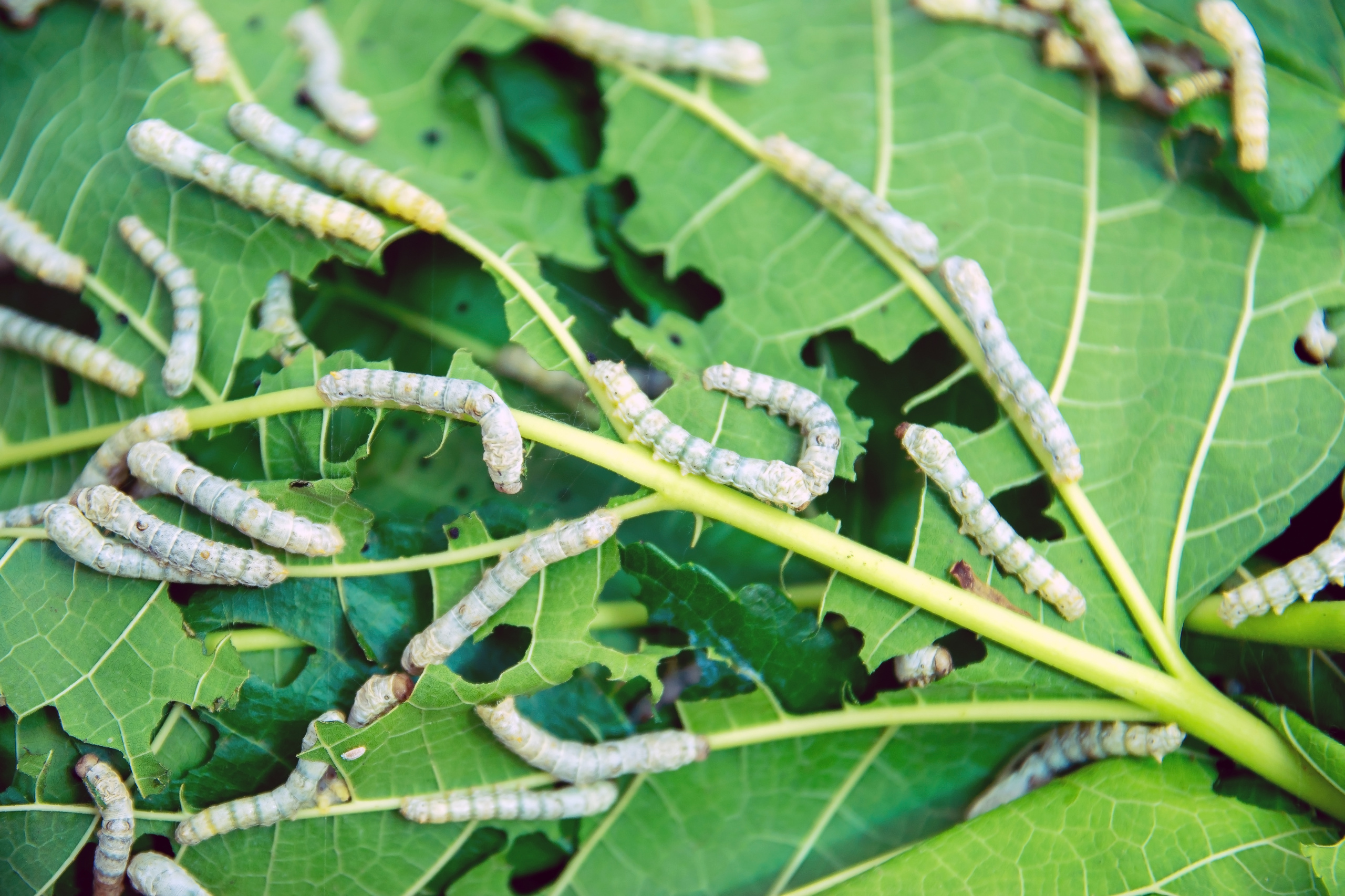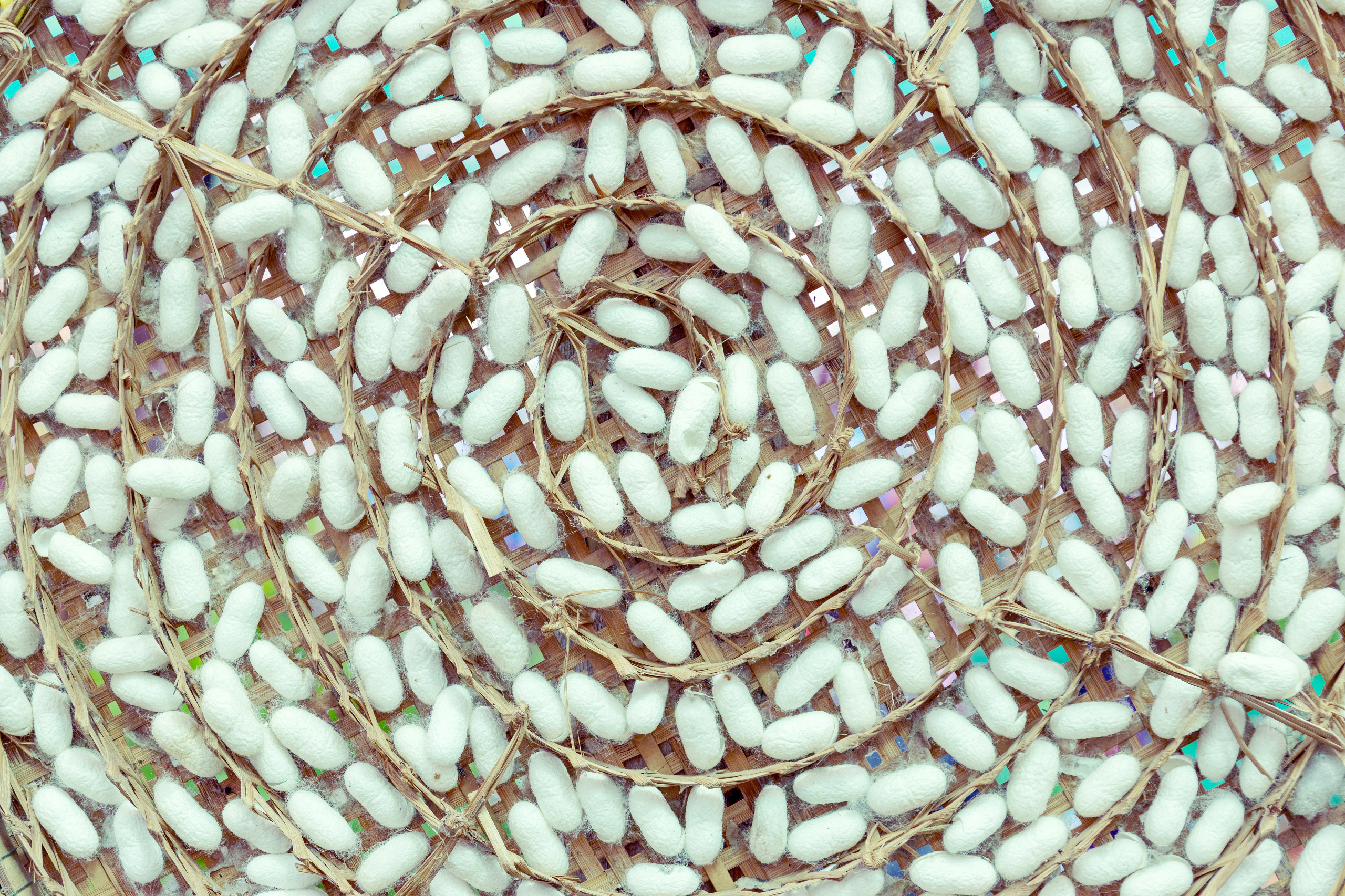Recommendation
Win-Win Textiles recommends the use of naturally renewable and biodegradable silk fibres, especially when grown organically, fair trade or recycled. Furthermore, peace silk – also known as eri silk or ahimsa silk – is becoming increasingly popular, as it does not involve the killing of the silk moths. Silk is the strongest natural fibre in the world. However, the lustre and softness of silk has made it a desired tradeware throughout history, building legendary trade routes and transforming cultures throughout the old world. It is an animal-based natural fibre, comprised of the natural protein fibroin that certain types of insect larvae secrete to make cocoons. While other insects also produce silk-like substances, most of the world’s silk is derived from the Bombyx mori larvae, which are worms that only live on mulberry trees. The production of silk using domesticated silkworms is called sericulture. It comprises the cultivation of mulberry, silkworm rearing and post cocoon activities, leading to production of silk yarn.
In 2019, around 75% of all silk was produced in China (409,515 tonnes). The second-largest producer was India (171,090 tonnes), with a market share of 22%. This means that China and India together produced around 97% of all silk worldwide. Other silk producing countries are Thailand, Uzbekistan and Iran. As a natural fibre, it is assumed that silk has high sustainability credentials; however, it is associated with a number of impacts, including animal welfare issues linked to boiling of the pupa, land and water use as well as labour issues.
Nonetheless, silk may be eligible for organic certification such as the Indian National Programme for Organic Production (NPOP), the Organic Content Standard (OCS), the Global Organic Textile Standard (GOTS), and the World Fair Trade Organization (WFTO). Additionally, recycled content product claims can be made where it is independently certified to the Global Recycled Standard (GRS), the Recycled Claim Standard (RCS) or the Recycled Content Certification (RCC) standards. Another preferred solution exclusively available for silk is peace silk. The production of this non-violent silk does not require killing the moth to extract the fibre. The moth leaves the cocoon after spinning and flies off. For this reason, peace silk is the preferred material of Buddhists and Vegans.
The Sustainable Development Goals
When changing to more sustainable silk concepts, brands will contribute to the SDGs:
Production
Conventional silk
Silkworms are cultivated in a controlled environment, feeding exclusively on mulberry leaves.
- After approximately six weeks, the silkworm, which is technically the larvae stage of the Bombyx mori moth, secretes a fibrous filament that creates the cocoon for the individual larvae.
- Whilst encased in their cocoons, the silkworms are placed in boiling water. This kills the silkworms and allows for the raw fibre of the cocoon to be unravelled.
- This fibre is then mechanically twisted into strands by a process called ‘throwing’, ready for fabric production.
The cocoon of the silkworm is small, and therefore large numbers (approximately 2,500 to 3,000) are required to make just half a kilo of raw silk fibre.
Preferred silk
- Organic silk is where the silkworm feeds on organically grown mulberry plants, meaning plants that are grown without the use of synthetic pesticides and fertilisers.
- Peace silk, also known as eri or ashima silk, is derived from a wild silkworm called Samia cynthia ricini. It is covered by its food, castor leaves, in a tribal area of Assam in India. As the moths leave the cocoons, a hole remains, and the strands cannot be reeled into a raw filament, but are spun like cotton or wool.
- Recycled silk yarn is made from industrial silk waste. The production scraps are collected and entangled, allowing them to be re-spun into new yarns.
Market situation
Conventional silk
Around 160,000 mt of silk was produced in 2019, and silk production volumes more than doubled from 1990 to 2019, but saw a decrease over the last five years. Even though the market share is small with less than 0.5% of total global fibre production, it is estimated that around 300,000 households are involved in the production of raw silk. Silk has traditionally been considered a premium fibre. Although expensive compared to many conventional fibres, it is widely available in small quantities. As a premium and often technically difficult fibre to process, silk is handled most commonly by specialist suppliers, limiting its ability to be integrated easily.
The majority of silk is not certified, making its communication potential limited. Visibility within the silk supply chain is limited, and tracing silk fibre will depend greatly on the level of visibility within the supply chain, as silk can be produced and processed in a number of differing global locations by multiple suppliers. Silk is expensive and its use remains marginal. This is largely due to the costly method of production and the limited quantities of silk fibre available on the market.
Preferred silk
There is no data available on the market situation of preferred silk. Therefore, availability is rare, and integration may be challenging. More sustainable options such as organic and eri/ahimsa (peace) silk have very limited availability, as they are produced by only a small number of suppliers. A few producers of organic silk are Triaz GmbH, which supports and owns 50% of Sichuan OTEX Textiles, the only producer of organic silk in China, producing 30 mt of silk filament a year, and Thailand-based Chul Thai Silk whose supply chain is GOTS certified. Product claims can be made for organic silk where it is independently certified by the Global Organic Textile Standard (GOTS) or the Organic Content Standard (OCS). Organic silk is where the silkworm feeds on organically grown mulberry plants, meaning plants that are not grown by using synthetic pesticides and fertilisers.
Even though recycled silk is not commercially available on the market, it is technically possible to recycle silk and have it certified by the Global Recycled Standard (GRS), the Recycled Claim Standard (RCS) or the SCS Recycled Claim. Even when considering its higher cost and the necessary investment in infrastructure, resources to track certifications and establish new sourcing channels, organic or recycled certification is relatively well-known amongst consumers. It therefore offers a good means of communicating the positive environmental and sustainability credentials on a product. Certification also ensures traceability, but increases the cost of this premium fibre even more.
The Japanese company Takihyo has established an eri (peace) silk project in Thailand. The silkworms eat the leaves of the local cassava plants, which are cultivated for their roots, an important source of food. The project provides an additional income to support the cassava farmers. The fecal byproduct is used as fertiliser for cultivating the cassava plants, and the pupa can be sold as food, for cosmetics or medicine once the silk is harvested. Another example producing organic ahimsa (peace) silk is the Indian company Cocccon, based in Jharkhand, India.
Sustainability considerations
Water is a key concern in the production of silk fibre. Silkworms depend entirely on the leaves of the mulberry bush as a source of food. Mulberry bushes require large amounts of water to grow, and they are often watered through irrigation and grown in countries with water scarcity. During its production and processing, silk uses a considerable amount of water. This is because so many silkworm cocoons are required per kg of silk fibre produced. In comparison, silk uses 95% more water than conventional viscose.
Minimal amounts of chemicals are used during the production of silk fibre. However, fertilisers are often used on the mulberry bushes, and detergents are used to remove sericin (a silk protein) during or after yarn production. When sourcing organic silk, one ensures no use of pesticides or insecticides. Although a minimal amount of land is used in the production of silk fibre, the mulberry bushes grown to provide food for the silkworms contribute significantly to the overall land use in the production of silk. Some research studies have highlighted the positive characteristics of mulberry bushes in controlling soil erosion. This is because the bushes have deep roots and can be planted on slopes, which can be subject to erosion after heavy rainfall. The production of silk is labour intensive, but sericulture can help employment in rural populations and thus prevent migration to big cities. It requires small investments, but there is evidence suggesting a high risk of occupational asthma among silk workers, caused by fine silk particulate released during its manufacture.
The production of silk involves boiling silkworms during the pupa (cocoon) stage of their development. Although there is debate as to whether silkworms actually feel pain, there are a small number of producers who choose not to boil the pupa. This way, the moths are allowed to hatch from their cocoons to avoid killing them. This approach is called ahimsa or eri (peace) silk. However, silk produced this way is not as strong and fine as conventional silk, as the moths break the silk fibres when they exit the cocoon.
Like all animal derived fibres, the use of silk is widely discussed within a sustainability context. On the one hand, it is a natural, renewable fibre that is biodegradable and super strong. On the other hand, the majority of silk is produced by killing the silk moths, which is not in line with a vegan lifestyle. Ashmia, eri or peace silk is a good compromise, combining the benefits of both sides.
New developments/outlook
Spider silk has remarkable mechanical properties when it comes to strength, elasticity and durability that rival many man-made materials, including nylon, Kevlar® and high-tensile steel. Because of the high cost of production, spider silk is not used in the textile industry, but scientists have been eager to copy its unique chemical and physical properties. Much insight into spider silk molecular structure has been driven by technological advances and innovations in biochemistry, molecular and structural biology, engineering, and physics. A few examples of biobased manmade protein fibre innovations are now commercially available e.g.:
- AMSilk Biosteel®, a biobased protein fibre produced in a continuous spinning process.
- Bolt Threads’ Microsilk, a biobased manmade spider silk, composed mainly of sugar, water, salts and yeast.
- Kraig Biokraft, a protein fibre made by genetically engineered and domesticated silkworms.
- Spiber’s Brewed Protein™, a protein-based material made through fermentation primarily from sugar, water, and mineral, which will become commercially available in 2021.



